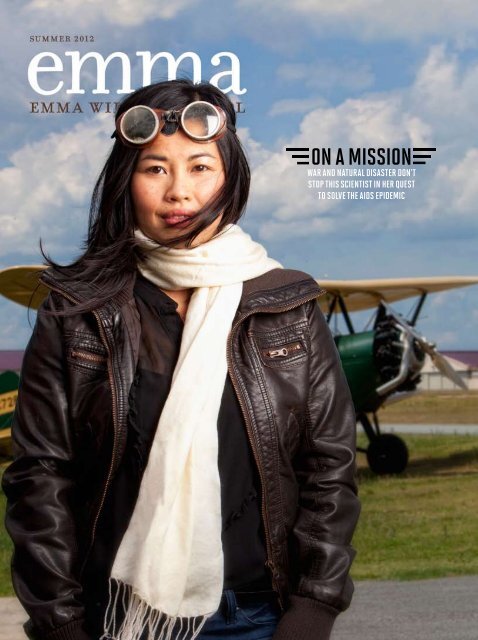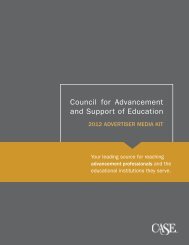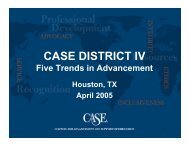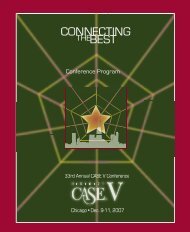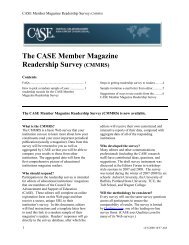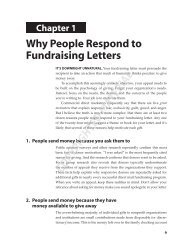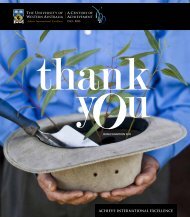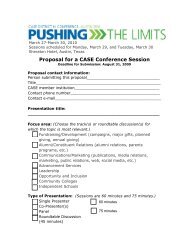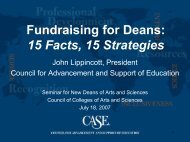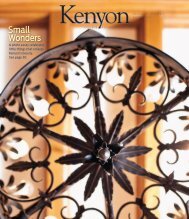Emma Magazine - CASE
Emma Magazine - CASE
Emma Magazine - CASE
- No tags were found...
You also want an ePaper? Increase the reach of your titles
YUMPU automatically turns print PDFs into web optimized ePapers that Google loves.
RECAPP Facility Evaluation ReportCapital HealthEdmonton General Continuing Care CentreB1025AEdmontonReport run on: February 27, 2009 2:20 PM
emma everywhere 03A Golden MorningIt was a beautiful day in Troy forthe 198th Commencement, andfamilies and faculty gathered towatch 85 remarkable girls receivetheir diplomas and begin thenext chapter of their lives.Every senior was personallyrecognized by Trudy Hall, whospoke of their accomplishments,their talents, and theiradventures. She then introduced“<strong>Emma</strong>’s unofficial dean ofphilanthropy,” Michal ColbyWadsworth ’65, who spoke withhumor about “the real world,philanthropy, and you.”Wadsworth has been instrumentalin the formation ofthe campus group, Phila,which is devoted to teachingstudents about philanthropy.She reminded the graduatingseniors to give back to <strong>Emma</strong>Willard. “You young womenwill go out into that real worldwith courage to serve and shapeyour world. With your support,generations of younger girls willfollow you. We who came beforeyou answered that call for you.Answer that for future students.”She was followed by Dr.Kathryn Moeller, a speaker atAUDACIA—a global forumfor girls’ education that <strong>Emma</strong>Willard sponsored in New YorkCity last fall. Dr. Moeller spokeabout her research on philanthropicprograms aimed atempowering girls and women.Before conferring the diplomas,Anne N. DePrez ’73,Chair of the Board of Trustees,awarded the Jameson AdkinsBaxter Award to Linnhe Kapnernoting her “uncommonly fulland good heart.” Erin Crotty’84, another board memberand past president of theAlumnae Association Council,awarded the Clementine MilllerTangeman Award to JuliaRiback. Crotty heralded Julia's“passion, intelligence, lively classpresence, and positive attitude.”Two senior speakers, ZhixingFei and Pei-Ting Hse, thenshared the stage for an unconventionaland humorous seniorspeaker farewell, at the end ofwhich, to mark the beginningof “life in the real world,” theyled the entiring graduatingclass in raising their voices toshout the song lyrics, “WE AREGOLDEN!” across Mount Ida. Summer 2012
ack in the day 05By Gabrielle demarcoWonder Woman of HistoryComic books—their colorful covers and tissue paper-thinpages filled with battling superheroes in shining capes—arean iconic part of American childhood, particularly for youngboys who purchased them at corner comic shops startingin the 1930s and continuing today.<strong>Emma</strong> Willard is the star of a WonderWoman comic from the 1940s.Superman stopped trains and Batman and Robin saved Gothamcity in every issue. The men of the comic book universe savedthe damsels in distress and flew off to victory.As America entered the 1940s with World War II raging inEurope, psychologist and inventor William Moulton Marstonenvisioned a totally new kind of superhero—a superheroine.Marston wanted to create a female superhero who would serveas a model of female power for the young girls of the time. Andso in 1941 DC Comics released Wonder Woman in all her starspangling,red go-go booted glory. With her Lasso of Truth andsleek mane of black hair, Wonder Woman completely upset theplace of women in the comic book world from crying victim tointernational intelligence agent and gave girls their own and firsteversuperhero.Shortly after Wonder Woman first came out, the artists and writerssought to offer girls real-world examples of “Wonder Womenof History.” And in 1946, our very own <strong>Emma</strong> Hart Willard andher important work for education and for girls was given a comic book treatment. Her life story was featuredin Wonder Woman issue number 17 as a model for what a dedicated woman could achieve.We were lucky enough to get access to this <strong>Emma</strong> comic, originals of which are valued in the hundredsand even thousands of dollars today. She stood as a true wonder woman then and continues to do so todaymore than 200 years later. Read about our very own caped crusader in all her penciled and zam-bop-powcomic greatness.“Wonder Woman completely upset the place of women in the comic bookworld from crying victim to international intelligence agent.” Summer 2012
10off campusBy Rachel mortonSky’s the Limit with NASA InternshipHannah Bower ’10 is looking for life on other planets. She’s not adreamer or a science fiction fan, she’s a scientist and she’s in aposition to discover them while working at NASA.When the rover craft, Curiosity, lands on Mars thisAugust, it will be relaying data back to NASA, data thatwill be analyzed using some of the techniques Hannahhas been testing. A sophomore at George WashingtonUniversity, Hannah landed the very competitive Tateinternship last summer to join a research group in thePlanetary Environment Lab at NASA. The scientiststhere were trying to refine techniques that would enablethem to find and quantify “organics” that were obtainedduring expeditions to Mars.“An organic compound is anything that containscarbon,” explains Hannah. “And carbon is essential forlife. So what we are looking for are any signatures oflife on Mars.”That is the “science for English majors” explanation.Here’s Hannah’s excited, full-speed, breathless explanationof what they are really doing: “We put knownconcentrations of water with polycyclic aromatic hydrocarbonsthrough a system where we collect organics andrun them through a gas chromatograph mass spectrometer.Then we compare it to a standard.”Hannah was already back at NASA one day a weekduring the school year, and will work there full timethis summer. Her new project is closely related to thissearch for organics on Mars, but this summer she’s tryingto find organics in deep cores of ice from the Arctic.Scientists believe that this glacial ice is similar to icefound on Mars and will provide a standard to whichdata from the Mars rover will be compared.Having a hand in such active, planetary research issomething most college students don’t have access to.Hannah is utterly jazzed by the science, the people sheworks with (“I’m so happy I have the mentors I have.They are absolutely awesome!”), and the opportunityto do science that has such an impact.“I used to think I’d go to medical school,” she said.“But now I really want to go to grad school and continuethis kind of work. I love planetary sciences!”This happy marriage of student and science beganat <strong>Emma</strong>, says Hannah’s mother, Ann Crotty ’83, whoknows firsthand how that can happen. It happened forher as well when she was a student at <strong>Emma</strong>. Thoughshe, too, liked science and math, she initially took adifferent path and became an elementary teacher.“I stumbled into science as a first-year, fifth-gradeteacher in an urban magnet school for math, science,and technology,” she says. “I ended up pursing a graduatedegree focused on science and education.” Herdoctoral dissertation was on women and girls in scienceeducation and it was fascinating seeing her own daughtertraveling this route.“I watched Hannah’s interest and excitementabout science gradually take shape in high school at<strong>Emma</strong>. As a parent and educator, I saw her interestpeaking during her sophomore year when she tookher first chemistry course. It may not have been her‘ah ha’ moment, but I recollect it was my ‘ah ha’moment for her.”Hannah Bower ’10 and her mother Ann Crotty ’83 bothdeveloped a love of science while at <strong>Emma</strong> Willard.emma
11off campusTrue, Ann had primed the pump. When her daughterswere young (another daughter, Sarah, a senior at<strong>Emma</strong>, is heading for Hobart William Smith Collegenext year to study life sciences), she’d point out metamorphicrock during walks on trails, take them to seean Imax movie on Jane Goodall, and plant seedlingswith them in the back yard. She made sure her daughtersknew women who were active practitioners inscience-related fields—doctors, mathematicians, engineers.“I always found a teaching moment,” says Ann,“whether they embraced it or not. Oftentimes not!”Hannah remembers those teaching moments. “Mywhole life I’ve been surrounded by science. We’d havelittle critters around; my mother would do experimentswith us. She wanted me to go to <strong>Emma</strong> because theyhave a good science program.”By the time Hannah graduated from <strong>Emma</strong> Willard,she had taken six years of science, including Physics,Chemistry, Biology, Animal Behavior, Ethics in Science,and Neuroscience, as well as four years of mathematics.Her most formative science experience came duringher junior year when she had an eight-week internshipat Rensselaer Polytechnic Institute in their biotechnologylab. Hannah says this was certainly the item on herresume that got her noticed by NASA when she was oneof many applicants for the internship there.“To me it was like a rehearsal for her future,” saidAnn about her daughter’s internship while at <strong>Emma</strong>.“She got to see how scientists work together and doscience, and to see herself in science, too.”It was particularly satisfying to Ann to watchHannah’s love of science grow and build into a careerpath because Ann’s experience as an educator had shownher that women and minorities are underrepresented inmany science fields.“The STEM pipeline is referred to as ‘leaky,’” she says,using the acronym often used for Science, Technology,Engineering, and Mathematics. The attrition rates ofwomen and minorities are especially high.But for girls inclined toward science at <strong>Emma</strong>Willard, Ann feels the environment is conducive.“She got to see how scientistswork together, and to seeherself in science, too.”“I think there is a much more concerted effort at <strong>Emma</strong>over the last decade or so to provide valuable and variedopportunities for students to gain access to science andmathematics courses that not only build their foundationalknowledge, but lead to more advanced coursesas they move from grades 9 to 12.”She cites the physics course for first-year students at<strong>Emma</strong>, noting that most schools offer physics to upperclassstudents only and often with prerequisites that barmany students who are not already confident sciencestudents. “This is a statement about the importance ofscience. How do you know you don’t like physics ifyou have never been exposed to it?” asks Ann.“Think of all the untapped potential in studentswho have never taken a physics or a chemistrycourse in high school—they could be, or couldhave been, our future engineers, physicists, chemists,bioengineers, biochemists.”No such questions linger for Hannah Bower,future planetary scientist. Next year she is transferringto the University of Maryland because, she says, “theirchemistry program is one of the top-ranked in the countryand they have close ties with NASA.” And NASAis where Hannah hopes to work, once she completes agraduate degree.“It was awesome to see my own daughter navigatingher way…gaining ground toward making such animportant commitment and decision about her future,”says Ann. “I describe her NASA experience as ‘life altering’because it did change her life. It has opened somany pathways, inspired her to take greater leaps. Shecan see a career with a future.” Summer 2012
12click“ Now, as you leave, I wish you anever-changing, ever-challenging,ever-satisfying life of beautifulmistakes, joyful blunders, andshimmering success. You, you arepoised to affect this world deeply.I cannot wait until you come backto tell me you did it.”—2012 baccalaureate remarks by PeteMcCorkle, Chief Administrative Officeremma
Photo: Mark Van Wormer
14actionBy Rachel mortonGiving It Everything She’s GotNatural leader gets top scholar-athlete awardLindsay Pattison grew up on 100 acres of fields and forest.She spent hours walking along a tributary of the Bozenkill River,hiking with her brother to the waterfall, to the bog, learningabout the animals who shared the bountiful wilderness—thedeer and bear, the birds and coyotes.This pastoral environment gave her a set of enduringpassions: love of the outdoors and physical activity,love of science and the natural world.Those aspects of Lindsay’s character came togetherthis spring when she was named the top basketballscholar-athlete in the Central Hudson Valley League.She was selected from top scholar-athletes representingnine Section II schools.In her acceptance speech, Lindsay thanked hercoach, Tony Holston. “There have been many lessonsthat Coach Tony has taught me through the game ofbasketball,” she said to a crowd of friends, coaches, andfamily members gathered at the Albany Marriot to celebratethe student nominees and winners. “But one ofthe most important ones has been to play with heart.To want the ball, to put everything you have into everysecond of every practice and every game.”During her last sectionals game, she was guardinga player who was a very good three-point shooter. “Iwas diving to intercept balls that were being passedto her or from her and usually landing on my side onthe floor, working hard to avoid picks on me so thatmy player could get open to take the outside shot, andtrying to keep up with my player,” she says. Thoughthey were down by many points and it was clear theywouldn’t win the game, Lindsay never let up.Lindsay Pattison ’12 was named the top basketball scholarathletein the Central Hudson Valley League.Photo: Mark Van Wormeremma
15actionIn the last two minutes of the game, the coachbegan pulling out the seniors and Lindsay was the lastone off. Coach Holston and Assistant Coach Quinnshook her hand and congratulated her, and as shewalked down the line of players on the bench, theyall stood and hugged her.“The team knew that I had given it my all and thatwas their way of thanking me—not just for playingwith heart and encouraging them to play with heartin this one game, but for the whole season.“There’s an intensity and power and drive when youplay like that. You are not thinking about anything else.That’s all there is at that moment. That desire.”Though she is passionate about sports and has competedon teams since she was five years old, Lindsaythinks of herself as a student-athlete, with emphasison the word student.“I love sports.” Lindsay asserts. “I love the game, thecompetition, but I’m a student first. I’ve always been intoacademics, and then sports.”How does a three-sport athlete with such commitmentto her teams manage to put that same spirit of “giving ither all” into her academics as well?Her biology teacher, Linda Maier, lauds Lindsay’s zealfor any challenge, her diligence, and her natural leadershipas a boon to any classroom. “Lindsay is absolutelyfantastic,” writes Maier, “her attitude, drive, motivation,sensitivity… She is bright, curious—a teacher’s dream!Whether in the classroom, on the athletic field, or mentoringher classmates, Lindsay gives 100 percent.”Lindsay’s AP Biology course with Maier was the firstbiology course she had taken, so the demands of thewritten materials and of the lab were new to her and sheneeded some guidance in how to handle it all. “It was adifficult course at first,” admits Lindsay, “but Miss Maierhelped me find ways to handle the course load better.”Maier says that Lindsay not only rose to the challengesof the class, but she was also a natural class leader. “Herdemanding athletic schedule coupled with her rigorousreading-intensive course selections could have been arecipe for disaster,” wrote Maier in a letter of recommendation,“however Lindsay took charge of her learning.”In order to attend classes, participate in sports practice,compete in games, complete homework, and still“There’s an intensity andpower and drive whenyou play like that. That’s allthere is at that moment.”have time to eat meals and have a little down time withfriends and family, Lindsay has learned to follow a preciseschedule.“I don’t watch TV,” she says. “I use all my free timewhen I’m not in class to do my homework. I’m organized;I’m on top of things.”Lindsay will continue with her science studies nextyear at Hamilton College, and though she’ll play sports,she expects it will be club sports, rather than intercollegiatecompetition.“There are other things I wantto explore,” she says, “like Outing Club.”Hiking is an important part of Lindsay’s life andit has been since she was an 11-year-old camper attendingCamp Chingachgook on Lake George. She recentlycompleted a leadership training program, where shehiked the high peaks of the Adirondacks. “We hikedabout seven high peaks in like four days,” she says withsome satisfaction.“I just like being outside,” she says. “I like nature.I like carrying the heavy pack and being a little dirty.I think I like uphills for some reason!”There are a lot of uphill moments in sports andLindsay has experienced them in not only hiking andbasketball, but in her other two sports—soccer andlacrosse. In the last game of the soccer season, the gamewent into overtime. It was snowing and she rememberssliding around the field. They’d already been playing for90 minutes but in spite of fatigue, “we were pumped.”In the end, there was just one final penalty shot andLindsay took it. “It was my last game. That’s the lastthing you can ever put into that game. I put all myfocus into the shot.”Though Lindsay’s shot went in, the team didn’t endup winning the game. But that part of it doesn’t fazeLindsay. “It was sad, but knowing I put so much intoit made it a better ending.” Summer 2012
16Photo: Billy Howardemma
17DangerousMedicine Scientisttackles AIDS epidemicin some of the world’smost dangerous placesBy Kim AschSummer 2012
18Yen Duong does AIDS research at the Centers for Disease Control headquarters in Atlanta, Georgia.When she’s at home in Atlanta, Yen Duong conducts her groundbreakingHIV research in a sterile, high-tech environment at Centersfor Disease Control headquarters. But the fearless microbiologist isequally at home when she’s working on the other side of the world inperilous places like South Sudan, Mozambique, and Afghanistan.The flak jacket-clad Ph.D. is like a female Indiana Jones, except instead ofwielding a whip in self-defense while searching for archeological treasures,she is armed only with a fierce sense of mission as she navigates war zones,natural disasters, and Third World conditions to advance a new technologythat could help conquer AIDS around the globe.Photo: Billy Howardemma
19Duong ’97 has spent the past three years in the field leading a comprehensiveeffort to assess the accuracy of a new CDC-developed lab test thatcan distinguish between long-term and recent HIV infections. The test providesvital information that can help direct international efforts focused onHIV prevention, care, and treatment. It helps to measure the rate of occurrence,the transmission dynamics, and allow tracking of epidemiologicaltrends. It provides crucial data during vaccine trials.“The test is fantastic. It’s spot-on accurate,” says Duong, whose name islisted first among eight authors of the journal article published in Marchannouncing the successful results.Once the test kit is commercialized, Duong predicts its use will be widespreadand to great benefit. She won’t see any profits from the sales, but shesays she wouldn’t have gone into the field of public health if she measuredher rewards in dollars and cents. “This has been a labor of love,” she says,adding with a laugh, “my program really attracts morons like me who feelthey can come in and save the world.”Debra Wadford, who collaborated with Duong investigating HIV inhibitorswhile pursuing their Ph.D.’s at UC Davis and is now a microbiologistfor the state of California, concurs that “none of us is in public health toget rich—we do it for the public good.” Wadford is proud of her friend’simportant work and a little awed by her daring.“When I try to text or call her, nine times out of ten she’s out of thecountry in some exotic, dangerous place. I wouldn’t want to go to any ofthose places, so kudos to her,” says Wadford. “She goes for the sake of thescience and the work. She goes regardless of the danger. But I think shealso gets a little rush from the adventure of it.”Anative of Vietnam who emigrated with her family when she wasvery young, Yen Duong (pronounced “Ing Dwon”) exudes anirrepressible exuberance about everything from great coffee (cappuccino:only froth, no milk) to viruses (“I love viruses, they’reso clever.”). She adores nature and food—and makes an effortto enjoy both wherever she is. “She always says her happiestplace is on the side of a mountain,” Wadford muses. “And sheis a fantastic cook—she can whip up the best simple, rustic pies in no time.”Duong attributes her wanderlust to what she calls her “geographicalconfusion” as a child. She spent her first years as an immigrant in bustlingLong Island, N.Y., before moving to small-town Saskatchewan in Canada,where her parents put in long hours at the bakery they continue to own andoperate. It was a cold, boring place, she says, “I only ever wanted to leave.”Boarding school offered an escape and Duong convinced her parents to lether go if she got in.“I went to the library and got a big directory and wrote letters to dozensof schools,” she recalls. “My dad picked <strong>Emma</strong> because it was the only girls’school in the mix.”At <strong>Emma</strong>, Duong was in her element. “I could be dorky and smartand still be accepted, instead of pregnant like many of the teenagers inmy hometown.”She painted, practiced photography, and sang in the choir. Having inheritedher parents’ cooking talents, she impressed her teachers by makingthem homemade Vietnamese spring rolls in their kitchens. But she reallyloved and excelled in Chemistry and AP Chemistry classes: “From there Iknew I was hooked on science.”“She goes forthe sake of thescience + thework. She goesregardless ofthe danger. ButI think she alsogets a littlerush from theadventure of it.”Duong majored in chemistryat McGill University in Montrealwhere her mentors groomed her forgraduate school. “Most of the peoplein the program were destinedfor the lab doing basic research,”she explains. “But I wanted to workon something to be used in thefield. Why do it if it’s not going todirectly affect people’s lives?”Upon completion of UC Davis’ssix-year doctoral program in pharmacologyand toxicology, she hadtwo patents to her name. Bothresulted from her work with potentialentry inhibitors to block HIVin the cell and stop its migrationto other cells. It’s unclear whetherthese compounds will ever becomeviable treatments, she says, because“it can’t go from my lab to people’smouths without industry comingin and putting tens of millions ofdollars into the development ofthe drug.”Summer 2012
20After completing her post-doc work at the CDC, Duong decided tostay on, even though she’d always imagined working for a nongovernmentalorganization. “I realized that it’s all about having an impact, andthe CDC has the weight of the United States government behind it,” shesays. And unlike a career in the pharmaceutical and biotech industries,Duong would be able to focus on the public health mission, free fromconcerns about profits and losses.“My parents cringe when they hear me say I don’t care about money.It causes them grief,” she says, without a hint of confusion. “I get it.They’re immigrants and they emigrated to achieve financial security.I’m secure, I just don’t want to be independently wealthy.”Instead, Duong prides herself on being a model governmentemployee. “When I go abroad I’m there to represent the U.S. governmentand I’m pretty serious about that. You have to represent properly.”Despite her independent and strong sense of identity, she dons a headscarf while working in places where they are the custom for women.“When I work with my Afghan colleagues, they offer tea which is agesture of kindness. It is rude to say no to the tea so even if I think I’mgoing to get sick from it, I drink it anyway. That’s how you build trustand a working relationship in that part of the world,” she says.Another aspect of her job with the CDC involves helping developingcountries create clinical lab systems to secure accurate results. Thework is akin to the proverb that it’s better to teach someone how to fishthan to give him a meal. The only place Duong refuses to go is Nigeriabecause, she says, the restrictive safety precautions would prevent herfrom getting anything done.“I joke that in my branch I’m like the civil unrest lab liaison,” shesays, adding that she chooses the uncomfortable and risky assignmentsbecause, “these are the places that need help the most. The need andthe ability to have an impact is what attracts me to them.”There is a lot of discomfort involved in her travels, which keepher away from her life in Atlanta about 40 percent of the year.Much of it is unavoidable, but even where modern accommodationsare available, Duong usually chooses to “rough it” bystaying in places that aren’t too far removed from the way thelocals live. “I figure as long as I have a bed, a shower, a sink,and clean water, I’ve got everything I need,” she says.Duong is rewarded by the way the sights, smells, sounds and tastes ofeach unique location so thoroughly work their way into her senses. “Onestrong sensory memory I have is of the dirt in southern Africa. It’s redand it has a smell to it and when I see and feel it, I know exactly whereI am in the world. There is no other place like it.“When I’m in South Africa, Mozambique, Swaziland, and Namibia,I try to go on safari as often as possible. I never get tired of seeing thegame there. In Swaziland, which has become my adopted homeland,they have a sanctuary for black rhinos that are officially extinct. I alsolove the elephants, lions, crocs and anything else I can see.”She says the people of Afghanistan have captured her heart. “Afterdecades of war the spirit of the Afghans is amazing. They really stillbelieve they can rebuild their country.” In poetic terms, she describesthe country’s effect on her: the way the dust and smoke rush into her“I joke thatI’m like thecivil unrestlab liaison.”nose and eyes and suck the moisturefrom her skin, the delicious kabobsand flat bread she eats with everymeal when she’s there. On one ofher visits, she and her colleagueswere able to go out to a local restaurant,and when they got there theywere greeted by an armed guard.“I like to start off all my meals withan AK-47,” she cracks.Maintaining a social life outsideof work is a bit of a challenge, butDuong manages to keep up withher friendships and even to date.She met a Marine while in Kabulwho returned to New York andshe sees him when she can. ForThanksgiving, she and a friendtoured Greece and Turkey, andat Christmas she was home inSaskatchewan to visit her family.Her work assignments inVietnam have allowed her to practiceher Vietnamese and reconnectwith her roots there. On a recenttrip to Vietnam, she bought a paintingof a child sitting on a water buffaloplaying a flute. “It’s an iconicVietnamese story and every timeI see this painting, it reminds mewhere I came from. I could be thatkid on a farm working today, butluckily I am not.”emma
21Setting the stage for our Bicentennial Celebrationin 2014, we present some of the pivotal peopleand meaningful moments in <strong>Emma</strong>’s history.The TimesThey WereA-Changinthe Dietel Decade at <strong>Emma</strong>In 1960,life at <strong>Emma</strong> Willard was much as it had beenbefore the Second World War. Girls wereprovided an excellent education by dedicated women teachers, andtheir activities and deportment were rigidly constrained.Summer 2012
22meaningfulmomentsin historyThere were rules for everything,and they were enforced by the two formidable co-headmistresses ofschool—Miss Anne Wellington and Miss Clemewell Lay. These womenhad been at the helm at <strong>Emma</strong> for nearly 20 years and the school theypresided over represented everything that had been prized in educationalcircles but was now being questioned by the emerging Boomer generation:a classical curriculum, social decorum, and nearly 150 years of tradition.The changes beginning to roil society were simmering quietly atthe school, held in check by the two imposing headmistresses, who wererespected and feared.Bill Dietel, who became principal of the school in 1961, succeedingWellington and Lay, remembers a moment as he was poised to take overthe school—a moment that was a beautiful illustration of the old andnew exchanging a bumpy embrace in passing.Before their official installation at <strong>Emma</strong>, Bill and his wife, LindaRemington Dietel ’48, were invited to spend the weekend on campus.Typical of an earlier era and in keeping with the formality of theschool and of the co-headmistresses, a tea with the seniors was plannedin Sage Living Room. Teacakes were served and the legendary GracieBartholomew played the piano.“Anne Wellington turned to me,” says Bill, “and said, ‘I think weshould do the gavotte.’“I looked at Linda. I didn’t know how to do the gavotte.”Bill realized what the rest of the girls knew full well. If AnneWellington said they should do the gavotte, well, it was time to do thegavotte. With Gracie’s piano accompaniment, the 33-year old Bill tookthe 64-year old Miss Wellington into his arms and they danced in frontof the transfixed seniors.“She led me!” Bills says. “Believe you me, Anne Wellington led mein the gavotte !”And on that note, Bill Dietel danced into his life at <strong>Emma</strong>.Once they moved to campus, Bill and Linda needed no such formalevents to get to know their students. They had four young children atthe time (a fifth was born while they were at <strong>Emma</strong>) and a pony. TheDietels would put their kids in a cart and let the little pony pull itaround the sidewalks on the inner campus. Needless to say, the studentswere captivated.That pony perhaps pointed the way to the Dietel's future life—on afarm, or, as their children like to call it, a “Fark”—part farm, part park.In Virginia rolling farm country, it includes homes for Bill and Linda,and for their daughter, Betsy, and her family.The farm part is Linda’s doing. She raised sheep for many years anddescribes herself as a retired sheep farmer. But “retired” for Linda doesnot mean sitting home knitting. She is heavily involved in communityand nonprofit fund raising, she created a foundation to support localpublic education, and she is active in the local Democratic Party. Bill,too, is active in the community (the two were named 2007 Citizens ofthe Year for service to the Rappahannock County), but his main businessis running an international philanthropic advising firm, helpingmajor investors use philanthropy for social change. Three of his childrenare principals in this firm.Though it has been more than 40 years since Bill and Linda’s tenureat <strong>Emma</strong>, they still feel deeply connected to the school. It is more thanthe fact that Linda is an alumna, that two of their daughters went to<strong>Emma</strong>, that Linda served on the Board of Trustees and was its president,and that she and Bill chaired the majorgifts part of a capital campaign in 1980and played a leadership role in the campaignof the 1990s.“We’ve had an association with theschool since 1946,” says Bill. “I wentto Exeter for four years during the warand I’ve remained very attached. I wentto Princeton, did graduate work at Yale.But <strong>Emma</strong>. <strong>Emma</strong> is special. That’swhere the family jelled and I maturedprofessionally,” says Bill.When Bill O Linda arrived in 1961, Billwas 33, Linda, 30. They came fromAmherst College, where Bill had beenassistant dean of the college. The arrivalof this young couple, with four youngchildren and a pony, was nothing lessthan astonishing.“He was a breath of fresh air,”says Trudy Hanmer, Associate HeadEmerita, whose history of the school,Wrought With Steadfast Will: A Historyof <strong>Emma</strong> Willard School is being publishedthis winter. “In January of thatyear, JFK was inaugurated and thereare a lot of parallels.”It was common at the time for thewives of secondary school heads to takeon major roles in running the schools,though they were unpaid and oftenunrecognized. Linda was a major assetto Bill and to the <strong>Emma</strong> community.“Linda was really co-principal,” Billsays. “It was fortunate for me,” saysLinda. “I knew the school inside outand backwards. A lot of faculty membersI had were still there.”At the time, the girls woreuniforms and the rules and regulationswere strictly upheld. Accordingto Hanmer, “there were rules for everything—evenhow you picked up yourfork.” The students were bridling underthe regulations, some of which were relicsof an earlier era.Though the Dietels did not abolishthe rulebook entirely, they did begin toloosen the strictures, “Bit by bit thesethings changed,” says Bill. “Not fastenough to suit all the girls, but movingin the right direction.”emma
Bottom left, clockwise: Bill and LInda Dietel came to<strong>Emma</strong> with four children and a pony; Bill with LucileTuttle, dean of admissions, reading news announcingplans for faculty housing; addressing the community;with a plaque naming the Dietel Library.23More importantly, they supportedthe students’ desires to join in thesocial and political actions takingplace in the world around them.When it came to civil rights, BillDietel “was keenly attuned to thetenor of the time,” says Hanmer,and he set an example for theschool. He was dedicated to increasingthe presence of black studentsand teachers on campus.In 1968, he took the studentsdowntown to a civil rights vigil.He provided transportation forstudents and faculty to go to a protestin Albany, and to RensselaerPolytechnic Institute to hear BobDylan. Linda was active in Troy,involved with the YWCA onimproving housing, and involvingstudents in community service.Bill’s colleague from Yale, WilliamSloane Coffin—then a vocal andrespected opponent of the war—came to the <strong>Emma</strong> campus andspoke on a few occasions.Bill’s liberal political stance wasn’talways popular among alumnae or“<strong>Emma</strong> is special.That’s where the family jelledand I matured professionally.”the Board of Trustees. When hetold the board he was going to tryto enroll 15 black students the nextyear, an alumna took him aside andtold him she didn’t approve. Butthat alumna, in spite of her disapproval,“ended up being one of themost supportive individuals in thehistory of the school,” he says.Where Bill made immediate andpermanent changes was movingthe school to a more professionaladministration. “I’d seen what wasgoing on at Amherst,” he says, andhe wanted that model for <strong>Emma</strong>.“A professional model,” he says,“means that you had people who areexperienced professional managersrather than a faculty member whois taken out of his Latin class twodays a week to become the financialsecretary. When I got here, therewas no development officer. Seriousindependent boarding schools couldnot survive with the old model.”When he arrived, the board wascomposed of businessmen from Troyand had been for decades. In fact,from 1872 to 1930 one Troy familyheld the board presidency.“We were an international schoolso a parochial board was inadequateto the challenges ahead,” says Bill.He proceeded to bring new bloodonto the board, including menwho could, and did, actively fundraise. In 1965 Clementine MillerTangeman ’23, was named presidentSummer 2012
24Bill and LindaDietel nowlive in Virginiawhere both areinvolved withnonprofit fundraising andinternationalphilanthropy.meaningfulmomentsin historyof the board—a pivotal momentfor the school and the first timean alumna had chaired the board.Tangeman was a national figureand had served on the board of thenational and international GirlsGuides and Scouts as well as charitiesat her homes in New York andColumbus, Indiana. Her impact onthe board and the school was legendaryand continues to this day.“Clemmie was one of the greatladies of the country,” says Dietel.People wanted to be on the boardwith Tangeman who was an inspiringleader.“Bill helped shape the board,” saysHanmer. He brought on alumnaeand men who would actively fundraise and who would recruit wealthy,well-connected individuals for theBoard of Trustees.While the addition of new bloodto the board—mostly men—wasn’tradical, the addition of new bloodto the faculty—mostly male—was.<strong>Emma</strong> had been an entirely femaleenterprise when the Dietels arrived(save two men, Russell Locke, headof the music department for 50 yearsand Arthur Homan, chair of the historydepartment when Bill arrived).But though there was moremoney spent, money was comingin. The Dietels instituted the firstcapital campaign in the history ofthe school. New buildings wereconstructed—the Tangeman housingcomplex, the Snell music wing,Dietel Library, and the facultyduplexes. Dietel discontinued theriding program and moved maintenanceto the old stables. He madethe laundry a student center.He took a decidedly less aggressivetack with the academic program.Academically the schoolwas nationally renowned when theDietels arrived. Co-headmistressesWellington and Lay had instituted acurriculum in 1948 that integratedthe history, literature, and arts ofWestern civilization, which, Lindasays, “was talked about in educationalcircles nationally.”By 1968, though, many of theteachers who had helped build thiscurriculum were gone, and newteachers, says Bill, “had new thingsthey wanted to do. They found aninherited program restrictive.”“So we tried to hang on to bitsand pieces of the old curriculumwhile giving faculty members moreof an opportunity to develop theirown areas of academic interests.”The school had always had aninterest beyond the United States,so there was a further broadeningbeyond Western civilization andculture. Also, science educationwas becoming more important inthe Sputnik era, so Bill beefed upmath and science and institutedan internship program. They alsoplaced a greater emphasis on thearts and started a dance programthat was of particular interest to agrowing number of students, andthough music and art had alwaysbeen strong, during Dietel’s era theyadded a performance component.If the former co-headmistresseswere known for strict formality andprotocol, the Dietels were knownfor their approachability, and in factmany students of the era referred tohim as “Daddy D.”“He was like a father figure,”recalls Mags Conant ’67. “I thinkmost people adored him. Hewas beloved.”In the spirit of the new Dietel era,pranks were played—by and on Bill.Bill recalls that when the girls realizedthat he didn’t really know all thewords to the Alma Mater, which wassung every week at morning assembly,one day the entire student bodystopped singing after the first verse,leaving Bill loudly singing his lah,lah, lahs.At another morning assembly,Bill introduced a visiting diplomatfrom Russia. “This was 1965,”Conant says, “so it was in the middleof the Cold War. The visitor wasdescribing why Russia was so wonderfuland what was wrong withAmerica.” She recalls that the studentswere getting perturbed and aFrench teacher in the balcony stoodup and left. After he finished hisanti-American speech, the Russiandiplomat sat down and Bill said,“We are very lucky to have today aparent of a student who would liketo refute the things you’ve just heard.Welcome Bill Chenoweth, the senatorfrom Colorado.” And then thesame guy—the Russian diplomat—stood up.Bill enjoyed making theannouncement of Headmaster’sHoliday a dramatic performance.On one occasion, while a speakeraddressed the students during morningassembly, the curtain behind himopened and there was Bill, in slippersand housecoat, reading the paperand smoking a pipe, exclaiming,“Headmaster’s Holiday!”Bill pulled another fast one onthe students when he insisted theyattend a special evening event—arenowned German poet would bereading poetry. The students wereunhappy and grumbled but arrivedto see a statuesque woman, ProfessorDoktor Gertrude von Rauschnitz,ascend the stage.Photo: Molly McDonald Petersonemma
25“She was tall, had good lookinglegs, and carried a reticule,” remembersBill. “And wore a veil and agray hat,” adds Linda.The poet proceeded to tell theassembly, in a thick German accent,that she was disappointed thatthey didn’t offer German classesor speak German.“The students were not amused,”laughs Bill. “Who is this womanputting our school down?”She began to read someGoethe and the students, boredand eager to get back to theirstudies, began squirming andwhispering. At which point thepoet railed at the students.“It’s extraordinary that youyoung ladies could be so badlybehaved!” she exclaimed. “It’senough to make me tear outmy hair!”So she did just that. Toreoff her hair—a wig, and beneaththat wig, was Bill Dietel. Pandemoniumensued. “It causedalmost complete bedlam amongthe students,” remembers KimiOkada ’69. “It was so funny,”says Linda, who was up in thebalcony laughing out loud.While the Dietel years at <strong>Emma</strong> werebuilding years—new structures,new programs, new teachers andadministrators—Bill and Lindarealized, by the end of their tenure,that all-girls’ schools were losingground. As many boys’ secondaryschools began going coed, the poolof <strong>Emma</strong> applicants was reducedand the future of all-girls education,at the secondary and collegiate level,began to look imperiled.In the years that followed, schoolschanged and evolved to meet thedemands and expectations of thechanging times. Some all-girls’schools became coed, some folded.But <strong>Emma</strong> Willard remained trueto its mission.“This school says,let’s go for it.”Then came the study by Harvardpsychologist Carol Gilligan that<strong>Emma</strong> underwrote. “That was animportant mind-changer about allgirls’ schools and women’s education,”Linda says.Gilligan asserted that developmentaldifferences between malesand females worked against youngwomen in educational settings,where they learned during pubertyto suppress their “authenticvoices” and true ideals in maledominatedsociety.“That put us back on thenational education scene,” Billsays. “That gave <strong>Emma</strong> a shot inthe arm. It’s part of the businessof being pioneering and takingchances. This school says, let’s gofor it. Finds a new way to be creative,to rethink women’s education.<strong>Emma</strong> Willard has historicallyconsistently played over its headand that explains the loyalty ofthe alumnae, the dedication of thefaculty, and the commitment ofthe board.”No one has been more loyal,dedicated, committed—or pioneering—thanthe Dietels.In 1969, Bill exited from hisrole as <strong>Emma</strong>’s principal with thesame drama and flair as when heentered it. “I will never forget thatday,” remembers Ann Evans ’72.“A helicopter began to circle overthe Triangle. Once it became clearthat the helicopter was going to landon the campus everyone gatheredto watch. My memory is that whenBill Dietel stepped out his armswere filled with daffodils and heannounced “Headmaster’s Holiday!”Approaching each and every studentand handing her a flower was hisway of saying farewell. He’ll neversay goodbye.Summer 2012
26by Marina Mezzogiorno-Brown ’06emmaPhoto: David Sosnow
27When she joined a circusschool in Italy, this alumnafound her footing.aerialathleteHow it all startedI began taking silks classes around two and halfyears ago because my mother, of all people, toldme she thought I’d enjoy flying. After about ayear of on-and-off classes and lots of fun with theBrooklyn/New York circus community, I felt thepull to go deeper. I started the professional programpart time at the Circus Warehouse in Queens doingsilks and flying trapeze (the best thing ever), ballet,and stretching classes. The school is absolutelygreat but too expensive to do full time and not ascomplete of an education as I realized I desired.Full-time, rigorous circus schools exist primarilyin Europe with a few in South and North Americaand Russia. My sister had twin boys in August of2011 in Italy so that helped me decide to headtoward Europe, as did the fact that I speak Frenchand Italian. I did some research, packed up my lifeand flew to Milan. A fantastic teacher of mine fromthe Circus Warehouse had mentioned she had seensome cool stuff come out of FLIC in Turin, so Iheaded there and there I stayed.Summer 2012
28I love to flyMy disciplines are the aerialrope and the silks. The ropehangs from a 25-foot ceilingin our school, and I climb andwrap and unwrap myself invarious ways, often includingdrops of 10 or more feet. Thesilks are similar except thatthere are two pieces of fabrichung from the ceiling.Photo: David Sosnowemma
The rush of performingThe adrenaline you get from having a public is unlike anything else.Performance is also the ultimate gratification for months of work, andthe place where you get to test your artistry. It is where, if you’re good,you get to force people to think outside the box and feel things theydon’t normally feel. That is the whole point of art when it is done well.29Developing a tough skinIt takes months to habituate your skin to the tear of the rope and yourhands to the hold you need to stay in the air. Most ropists (includingme) wear jeans to practice and perform, as tights just don’t cut it. Itrequires a huge amount of strength as well—the majority of movementsstart with a pull up, at the very least. Constant concentration isimperative when you’re talking about acrobatic movements at 20 feetin the air—one misstep and you break a vertebra. Not an uncommoninjury, unfortunately, at FLIC.At the end of the day I have just enough energy left to get home,cook dinner and pass out. In fact, I’d like to take a moment to apologizeto all of my lovely <strong>Emma</strong> girls for my absolute lack of contact.I love and think about you all! I just can’t move most of the time!I spend my days trying to reachthe limit of what physics (andcommon sense) permit.My class scheduleFor one hour in the morning we have physical preparation, whichconsists of either strength building or flexibility training. We’re talkingan hour of pull-ups, push-ups, ab closures, jumping, etc., in every possibleconfiguration the devil can come up with—hands close together,hands far apart, elbows wide, elbows at 90 degrees, squatting, legs at 30degrees, legs straight jumping with only your ankles, and that doesn’teven begin to explain the depth of variation. Flexibility focuses onlegs, joints (hips/shoulders), and back. This means minutes in all three,splits, bridges, straddles and so on. Physical prep is followed by acrobatics—Ican now do a round-off back handspring and am working onmy round-off back flip! We then have modern dance class. It’s superexciting to mix disciplines; that is, throw a handstand or a cartwheelinto a dance choreography. This interdisciplinary fluidity is the objectiveof FLIC’s training. We also have physical acting classes, mask andclown workshops, as well as intense stretching lessons. The final pieceis, of course, circus class. Aerial rope and the silks. Swinging trapeze,aerial hoop, tight wire, hand to hand, roux cyr, German wheel, Chinesepole, acrobatic ball, ladder, hand standing, and if you are interested youcan work on juggling and contortion as well.Not just clowning aroundContemporary circus is nowhere nearthe “TA DA!!” of traditional circus—traditional being the sort with paradinganimals and trapeze artists in glitteringtutus. Today’s circus is closer to a mixtureof modern dance, acting, and madskills. It is about pushing the audience,and performer, into a world where thelaws of physics and common sense areless applicable. It is not easy and oftenit is not fun in the sense that the word“circus” brings to mind.What circus means to meIt is about using the body as your artisticinstrument—learning to controlyour movement and your discipline(mine is the rope) in such a way thatyou can express something deeper thanthe sum of your tricks. In this worldthere will always be the gymnasts anddancers that began at age six who bestyou technically—the challenge is to findwhat makes your performance moving,to find how you can use your body toshow your soul, your ideas, and to usethat to move people.Forget sick daysConsistency is also a huge, huge elementfor physical fitness. In mostschools if you are sick they tell you tostay home. At FLIC, unless you can’tmove you better show up. A cold is notan excuse; neither is a pulled muscle ora twisted ankle. The first show at theschool I performed with a fracturednose from doing a certain type of twopersonfront flip.Summer 2012
30My ‘gritty’ new communityThis is still a fringe community, even if the numberof people in circus is exploding, and the people yourun into are some of the most cooperative and grittyyou will find anywhere. The ideal is to have your ownChapiteau (tent) and travel as an autonomous group.That means you are always with the people in thecompany (a bit like <strong>Emma</strong>, you are forced to get alongwith the people around you, you live with them), andyou share everything. You share the work of mountingand dismounting the tent (no small feat), you sharefood, you share ideas, you share creation time and youshare down time. This is the politic of circus. It is, onone hand, super individualistic because everyone worksfor themselves with their own number. On the otherhand it is ultra-communal. It is an intense combinationand a great balance for me.When you’retalking aboutacrobaticmovementsat 20 feet inthe air—onemisstep andyou break avertebra.More than a dress rehearsalMonthly or bimonthly the whole school puts togethera show under the direction of various artists. Theseshows are nothing like a cabaret, they are full-onproductions with a theme and often carry a vaguestory line. We don’t sleep from Thursday until 3 a.m.Sunday when the show is over and the gym-turnedtheateris dismantled and returned to normal. I wastotally taken aback when I saw the number of peoplethat showed up to the first Circo In Pillole—theschool’s shows have become something of a sensationin Turin and a few hundred spectators come.Reconnecting with my Italian sideI am half Italian and half American. The Italian half isall here in Italy, including my sister who was born andraised here. I was born and raised in the US but havedual citizenship. When I was young I came here onceevery two or three years to see my family, and whenI was 16 I decided to spend my junior year of <strong>Emma</strong>in Italy to learn the language.Surrounded by colorful charactersThere are students from all over the world—Brazil,Costa Rica, USA (I’m not the only American),France, Spain, Austria, Poland, all over Italy, Sweden,Latvia, Ireland, and so on. I guess the biggest differencebetween the people in this school and the otherschools I’ve been to is that here we all work with ourbodies in an extreme way, for which a certain madnessis a base requirement.Photo: David Sosnowemma
31If I had a crystal ballIn five years I hope to be workingwith a company of brilliant artiststraveling the world with our show.Summer 2012
emma willard school285 Pawling AvenueTroy, NY 12180SAVE THE DATE Reunion 2013, June 8–10Classes of 1933, 1938, 1943, 1948, 1953, 1958, 1963, 1968, 1973, 1978, 1983, 1988, 1993, 1998, 2003, 2008If you’d like to volunteer for Reunion, please call or email the Alumnae Relations Office at 866-833-1814 toll-free or alumnae@emmawillard.org. Look for your invitation in March with all the details of the weekend’s activities.


